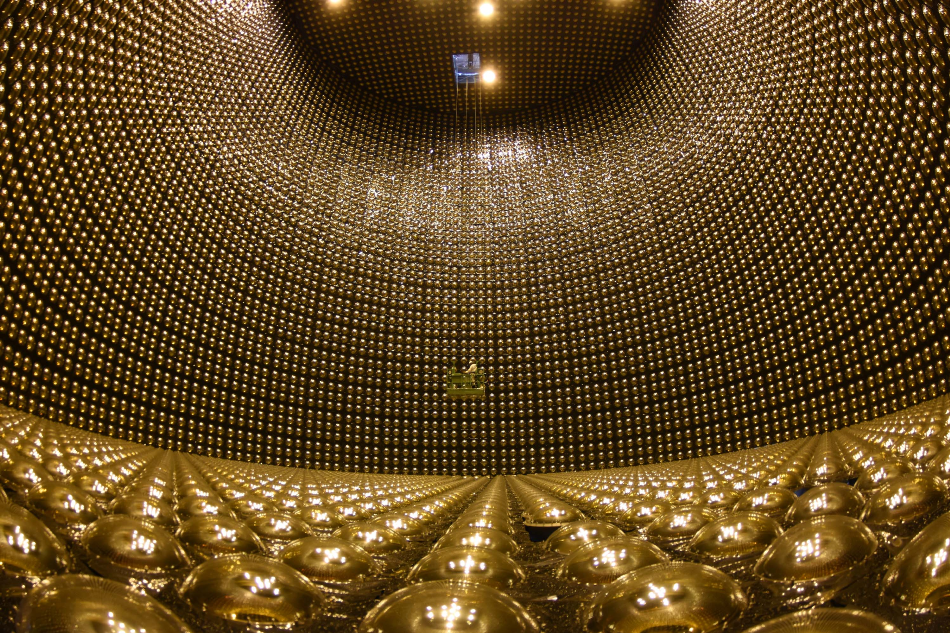Aug 24 2020
The Super-Kamiokande neutrino observatory has the potential to detect various types of neutrino-related phenomena, such as supernova explosions in the Milky Way galaxy.
 Inside Super-Kamiokande. The observatory is lined with 13,000 photomultiplier tubes, which amplify weak flashes of light. Image Credit: © 2020 Kamioka Observatory, ICRR (Institute for Cosmic Ray Research), The University of Tokyo.
Inside Super-Kamiokande. The observatory is lined with 13,000 photomultiplier tubes, which amplify weak flashes of light. Image Credit: © 2020 Kamioka Observatory, ICRR (Institute for Cosmic Ray Research), The University of Tokyo.
In general, it is filled with pure water. However, recently, it has obtained a dose of gadolinium, a rare-earth element. With this addition, the observatory will be able to observe supernova explosions even in very distant galaxies.
The Super-Kamiokande neutrino observatory is a massive cylinder with a height of 40 m and filled with 50 million liters of water. It has been buried 1 km underground close to the city of Hida in central Japan. Since 1996, it has been used to see subatomic particles and neutrinos from terrestrial, solar, extrasolar, and artificial sources.
The observatory uses highly sensitive optical sensors to detect these particles. These sensors record minuscule flashes of light that appear when a neutrino interacts with a molecule of water.
Neutrino events are generally very difficult to record. Therefore, the sensors must be highly sensitive. The mass of neutrinos is so less that they virtually pass through ordinary matter as if it doesn’t exist, and interact with the matter only rarely.
Since the observatory has been constructed deep underground, it enables other types of radiation and particles to be blocked but permits neutrinos to penetrate the chamber, quite similar to a filter.
The unique properties of the light flashes inform scientists about the type of neutrino detected by them, as there are different kinds based on the different phenomena through which they are created.
Researchers are determined to detect specifically anti-electron neutrinos as those can offer quite a lot of information about the universe. A supernova has already been detected in the Milky Way galaxy, but they tend to occur only rarely, with a gap of several decades.
Therefore, researchers look beyond supernovae that occurred billions of years ago in faraway galaxies. However, there is a roadblock.
Neutrino signals from such faraway supernovae are extremely weak and difficult to differentiate from the background noise. The telltale flashes indicating a supernova event require a boost to enable researchers to extract the signal.
The key is to combine an impurity to the water that generates bright flashes as a response to the neutrons generated by antielectron neutrino interactions. This impurity does not otherwise have any impact on the observations at Super-Kamiokande.
Scientists have added multiple tons of gadolinium, a rare-earth element, into the otherwise pure water. Upon interacting with neutrons generated by specific neutrino interactions, gadolinium emits a gamma-ray flash that can be easily detected.
From these flashes, researchers can indirectly learn about the neutrinos that generated them. At first, the researchers added 13 tons of a gadolinium compound, thus offering a gadolinium concentration of around 0.01%. This will be further increased by the researchers to further enhance the sensitivity to neutrino events.
With a gadolinium concentration of 0.01% Super-Kamiokande should detect neutrons from neutrino collisions with 50% efficiency. We plan to increase the concentration in a few years to increase efficiency. I hope we can observe neutrinos from ancient supernovae within a few years.
Masayuki Nakahata, Professor, The University of Tokyo
Nakahata is the supervisor of this project.